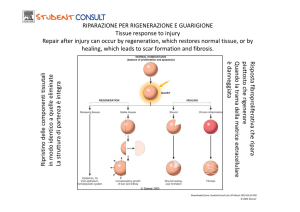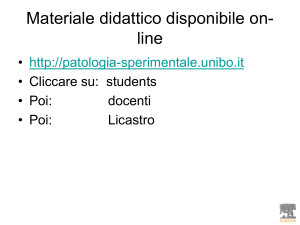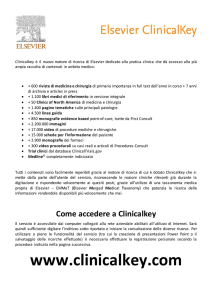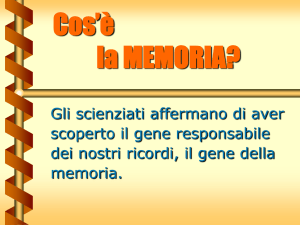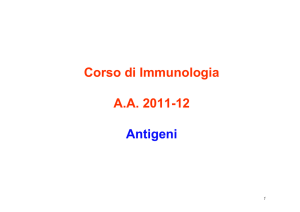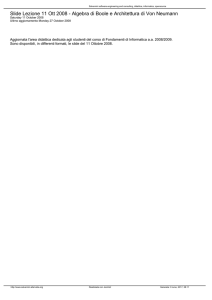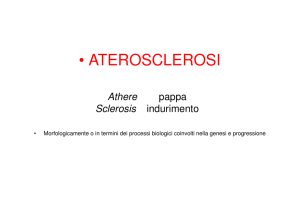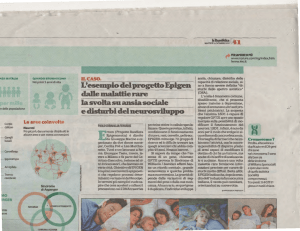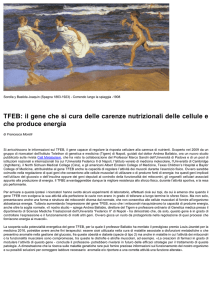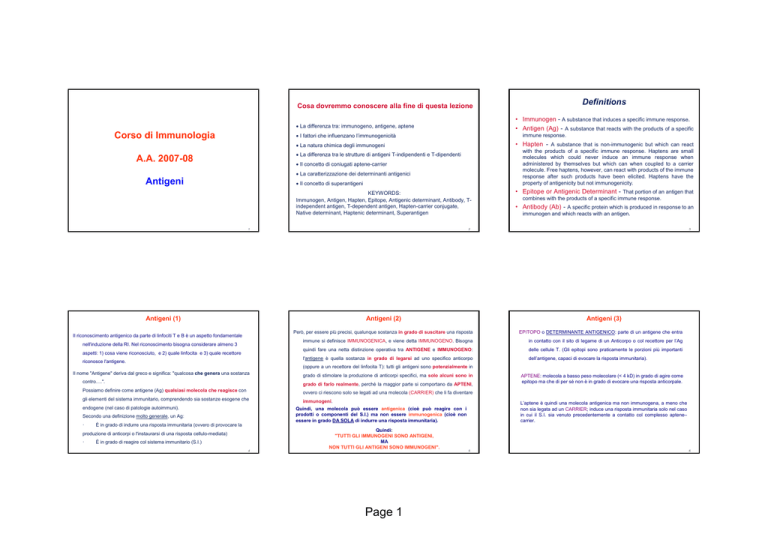
Definitions
Cosa dovremmo conoscere alla fine di questa lezione
• Immunogen - A substance that induces a specific immune response.
• Antigen (Ag) - A substance that reacts with the products of a specific
• La differenza tra: immunogeno, antigene, aptene
Corso di Immunologia
• I fattori che influenzano l’immunogenicità
immune response.
• Hapten - A substance that is non-immunogenic but which can react
• La natura chimica degli immunogeni
with the products of a specific immune response. Haptens are small
molecules which could never induce an immune response when
administered by themselves but which can when coupled to a carrier
molecule. Free haptens, however, can react with products of the immune
response after such products have been elicited. Haptens have the
property of antigenicity but not immunogenicity.
• La differenza tra le strutture di antigeni T-indipendenti e T-dipendenti
A.A. 2007-08
• Il concetto di coniugati aptene-carrier
• La caratterizzazione dei determinanti antigenici
Antigeni
• Il concetto di superantigeni
KEYWORDS:
Immunogen, Antigen, Hapten, Epitope, Antigenic determinant, Antibody, Tindependent antigen, T-dependent antigen, Hapten-carrier conjugate,
Native determinant, Haptenic determinant, Superantigen
1
Antigeni (2)
nell'induzione della RI. Nel riconoscimento bisogna considerare almeno 3
aspetti: 1) cosa viene riconosciuto, e 2) quale linfocita e 3) quale recettore
riconosce l'antigene.
combines with the products of a specific immune response.
• Antibody (Ab) - A specific protein which is produced in response to an
immunogen and which reacts with an antigen.
2
Antigeni (1)
Il riconoscimento antigenico da parte di linfociti T e B è un aspetto fondamentale
• Epitope or Antigenic Determinant - That portion of an antigen that
3
Antigeni (3)
Però, per essere più precisi, qualunque sostanza in grado di suscitare una risposta
EPITOPO o DETERMINANTE ANTIGENICO: parte di un antigene che entra
immune si definisce IMMUNOGENICA, e viene detta IMMUNOGENO. Bisogna
in contatto con il sito di legame di un Anticorpo o col recettore per l’Ag
quindi fare una netta distinzione operativa tra ANTIGENE e IMMUNOGENO:
delle cellule T. (Gli epitopi sono praticamente le porzioni più importanti
l'antigene è quella sostanza in grado di legarsi ad uno specifico anticorpo
dell’antigene, capaci di evocare la risposta immunitaria).
(oppure a un recettore del linfocita T): tutti gli antigeni sono potenzialmente in
Il nome "Antigene" deriva dal greco e significa: "qualcosa che genera una sostanza
grado di stimolare la produzione di anticorpi specifici, ma solo alcuni sono in
contro….".
grado di farlo realmente, perché la maggior parte si comportano da APTENI,
Possiamo definire come antigene (Ag) qualsiasi molecola che reagisce con
ovvero ci riescono solo se legati ad una molecola (CARRIER) che li fa diventare
gli elementi del sistema immunitario, comprendendo sia sostanze esogene che
endogene (nel caso di patologie autoimmuni).
È in grado di indurre una risposta immunitaria (ovvero di provocare la
produzione di anticorpi o l'instaurarsi di una risposta cellulo-mediata)
·
L’aptene è quindi una molecola antigenica ma non immunogena, a meno che
non sia legata ad un CARRIER; induce una risposta immunitaria solo nel caso
in cui il S.I. sia venuto precedentemente a contatto col complesso aptene–
carrier.
Quindi, una molecola può essere antigenica (cioè può reagire con i
prodotti o componenti del S.I.) ma non essere immunogenica (cioè non
essere in grado DA SOLA di indurre una risposta immunitaria).
Secondo una definizione molto generale, un Ag:
·
immunogeni.
APTENE: molecola a basso peso molecolare (< 4 kD) in grado di agire come
epitopo ma che di per sé non è in grado di evocare una risposta anticorpale.
È in grado di reagire col sistema immunitario (S.I.)
4
Quindi:
"TUTTI GLI IMMUNOGENI SONO ANTIGENI,
MA
NON TUTTI GLI ANTIGENI SONO IMMUNOGENI".
Page 1
5
6
Antigeni (4)
Antigeni (5)
Antigeni (6)
KARL LANDSTEINER (1921):
Da questi esperimenti Landsteiner dedusse perciò il concetto di aptene e formulò 2
Un antigene possiede normalmente più di un epitopo, quindi la risposta che
indurrà sarà policlonale, cioè verranno attivati più cloni linfocitari. Vi
Iniettando in un coniglio un estratto alcolico di rene (ridotto a piccoli frammenti) di
cavallo notò che l’animale non produceva Ac; ma addizionando all’estratto un
sono tuttavia alcune molecole antigeniche che posseggono uno o pochi
una
gerarchia
nell'immunodominanza
degli
epitopi,
Il livello di reattività crociata verso un aptene indica il grado di specificità
L’importanza dell’esperimento di Landsteiner risiede comunque nel fatto di aver
vengono attivati pochi cloni). All'interno di una molecola antigenica può
vigere
Gli Ac reagiscono maggiormente con apteni omologhi
·
omogenato di rene (frammenti di dimensioni maggiori ) il coniglio produceva Ac .
epitopi immunodominanti, e sono in grado quindi di indurre una risposta
monoclonale (se un solo clone viene attivato) od oligoclonale (quando
regole generali:
·
con
dimostrato che l’estratto alcolico di rene di cavallo è un APTENE, cioè non è
(per reattività crociata si intende il fenomeno per il quale un Ac che reagisce con una
immunogeno se inoculato da solo, ma solo se insieme a una proteina
determinata molecola è in grado di reagire anche con un’altra molecola ma con
CARRIER, in questo caso l’omogenato di rene.
minore affinità: es. miocardite post-streptococcica ).
conseguente attivazione preferenziale di alcuni cloni confronto ad altri.
7
8
Antigeni (7)
9
Caratteristiche antigeni (1)
Caratteristiche epitopi (1)
CARATTERISTICHE CHE DEVE AVERE UNA PROTEINA AFFINCHE’ FUNZIONI
Attraverso prove di sostituzione aminoacidica e cross-reattività Landsteiner ha
stabilito l’importanza di alcune caratteristiche:
·
POSIZIONE degli aminoacidi con cui reagisce l’Ac
·
GRANDEZZA
·
CARICA
·
STEREOISOMERIA (stereoisomeri diversi danno risposte diverse )
·
DA ANTIGENE:
1.
Peso molecolare (superiore a 5.000Da). Infatti, più una proteina è grande e
complessa, più verrà spezzettata e frammentata (come vedremo, le molecole
MHC hanno preferenza a legare e presentare frammenti peptidici, e non
proteine intere).
Nel 1960 SELA studiò l’immunogenicità di diverse catene laterali
·
Complessità chimica
·
Solubilità (necessaria per il trasporto)
·
Estraneità (infatti l’Ag deve differenziarsi il più possibile dalla forma delle
proteine self, altrimenti si ha l’instaurarsi di patologie autoimmuni)
·
Dose di somministrazione: sotto certe dosi, molte proteine non sono in grado
di provocare una risposta immune. A dosi molto alte, d’altra parte, la risposta
immunitaria è inibita. In alcuni casi, dosi troppo alte o troppo basse possono
indurre stati irresponsivi noti come "Tolleranza acquisita da bassa o alta dose".
Le Risposte Secondarie in genere necessitano di una dose più bassa di Ag,
come conseguenza dell’instaurarsi della Memoria Immunologica.
·
I determinanti antigenici devono essere accessibili agli anticorpi
(Ac)
aminoacidiche legate ad uno scheletro polilisinico (il S.I. non reagisce
contro polimeri di molecole identiche ripetute): se il determinante
antigenico delle catene (dato da residui di ac. Glutammico o tirosina
legati a polialanina ) risulta inaccessibile agli Ac non si ha risposta
immunitaria,
risposta
che
compare
invece
in
seguito
allo
smascheramento degli epitopi (aumentando ad esempio la distanza fra
catene)
Via di somministrazione: di solito la Via Sottocutanea è la più potente.
10
11
Page 2
12
Caratteristiche epitopi (2)
2.
Caratteristiche epitopi (3)
Caratteristiche epitopi (4)
3.
I determinanti antigenici possono essere continui o discontinui
Negli anni ’60 A. Tassi fece degli studi su mioglobina di balena e trovò che in
questa molecola di 153 a.a. erano presenti 5 regioni in grado di provocare
Gli epitopi lineari, in particolare, sono riconosciuti sia dai linfociti T che dai
I Determinanti Antigeni possiedono alcuni residui più importanti
di altri (EPITOPI IMMUNO-DOMINANTI).
Durante l’ ipermutazione somatica gli Ac ad affinità maggiore sono quelli
diretti contro epitopi dominanti (epitopi immunodominanti) mentre quelli
meno affini contro epitopi più nascosti.
linfociti B mentre quelli conformazionali solo dai linfociti B.
una risposta anche dopo la frammentazione della molecola e che tali
regioni risultavano essere su zone esposte e flessibili. Questi tipi di
ATTENZIONE: gli epitopi lineari sono anche conformazionali, ma non è
determinanti antigenici sono detti continui (o lineari) poiché dati da a.a.
vero il contrario; infatti l’immunogenicità di una porzione proteica
disposti in modo lineare, cioè uno dopo l’altro nella sequenza primaria
dipende da come essa è presentata (potenzialmente qualsiasi porzione
della proteina. Esistono però altri tipi di determinanti, la cui esistenza è
di una molecola può essere immunogena se presentata correttamente).
stata dimostrata successivamente utillizzando molecole di lisozima, detti
Nel corso di una risposta immunitaria si ha quindi una sorta di "Selezione
Darwiniana" tra gli epitopi più importanti, verso i quali vengono prodotti
Ac più "forti".
Da qui deduciamo che gli Ag hanno porzioni più o meno importanti e che gli
epitopi immunodominanti si trovano su porzioni idrofiliche degli Ag
(perché piu’ facilmente raggiungibili dagli Ac) piuttosto che idrofobiche.
Essendo questi epitopi quelli contro cui, con maggiore probabilità,
reagiranno gli Ac, anche in individui diversi, sono solitamente utilizzati
per la preparazione di vaccini.
discontinui (o conformazionali) formati da a.a che erano discontinui nella
sequenza primaria, ma che diventano contigui nella struttura terziaria,
perché sono portati ad unirsi grazie al ripiegamento tridimensionale della
proteina. (ad es. 2 regioni legate da ponti disolfuro). Alla luce di ciò
possiamo probabilmente attribuire il successo degli esperimenti di Tassi
alla relativa semplicità strutturale della globina.
13
14
Caratteristiche epitopi (5)
4.
• Foreigness
all’anticorpo di "incastrarsi" bene (ricordando un po’ un meccanismo
chiave-serratura, in cui però la chiave è fatta di gomma!).
- The immune system normally discriminates between self
and non-self such that only foreign molecules are immunogenic.
• Size
- There is not absolute size above which a substance will be
immunogenic. However, in general, the larger the molecule the more
immunogenic it is likely to be.
• Chemical Composition
Le forze in gioco nel legame Ag-Ac (non covalente):
•
Interazioni elettrostatiche
•
Forze di Van der Waals
•
Interazioni idrofobiche
Contribution of the Immunogen
Contribution of the Immunogen
L’antigene è dotato di una certa mobilità strutturale in modo da permettere
Ponti idrogeno
Factors Influencing Immunogenicity
Factors Influencing Immunogenicity
Mobilità del sito antigenico:
•
15
–
–
–
–
16
Primary Structure
Secondary Structure
Tertiary Structure
Quarternary Structure
Sequence determinants
Conformational
determinants
In general, the more complex the substance is chemically the more
immunogenic it will be. The antigenic determinants are created by the primary sequence of
residues in the polymer and/or by the secondary, tertiary or quaternary structure of the
molecule.
17
Page 3
•
•
•
•
Foreigness
Size
Chemical Composition
Physical Form
– Particulate > Soluble
– Denatured > Native
In general particulate antigens are more immunogenic than soluble
ones and denatured antigens more immunogenic than the native
form.
18
•
•
•
•
•
Factors Influencing Immunogenicity
Factors Influencing Immunogenicity
Contribution of the Immunogen
Contribution of the Biological System
Factors Influencing Immunogenicity
Method of Administration
• Dose -
The dose of administration of an immunogen can influence its
immunogenicity. There is a dose of antigen above or below which the immune
response will not be optimal.
• Genetics
Foreigness
Size
Chemical Composition
Physical Form
Degradability
– Species
– Individual
• Route
– Subcutaneous > Intravenous > Intragastric
• Responders vs Non-responders
– Ag processing by Ag Presenting Cells (APC)
Antigens that are easily phagocytosed are generally more immunogenic. This
is because for most antigens (T-dependent antigens, see below) the
development of an immune response requires that the antigen be
phagocytosed, processed and presented to helper T cells by an antigen
presenting cell (APC).
Some substances are immunogenic in one species but not in another.
Similarly, some substances are immunogenic in one individual but not
in others (i.e. responders and non-responders). The species or
individuals may lack or have altered genes that code for the receptors
for antigen on B cells and T cells or they may not have the appropriate
genes needed for the APC to present antigen to the helper T cells.
Generally the subcutaneous route is better than the intravenous or intragastric
routes. The route of antigen administration can also alter the nature of the
response
• Age -
Substances that can enhance the immune response to an immunogen are called
adjuvants. The use of adjuvants, however, is often hampered by undesirable
side effects such as fever and inflammation.
• Adjuvant
– Substances that enhance an immune response to an Ag
This can also influence immunogenicity. Usually the very
young and the very old have adiminished ability to mount and immune
response in response to an immunogen.
19
20
21
Properties of T-indipendent antigens
Types of Antigens
T-independent
Chemical Nature of Immunogens
•
Antigens
-
T-independent
antigens
The vast majority of immunogens are proteins. These
may be pure proteins or they may be glycoproteins or lipoproteins. In
general, proteins are usually very good immunogens.
-
Pure
lipopolysaccharides are good immunogens.
polysaccharides
and
Polymeric structure - These antigens are characterized by the
•
Polyclonal activation of B cells - Many of these antigens can
are
same antigenic determinant repeated many times.
antigens which can directly stimulate the B cells to produce
• Proteins -
• Polysaccharides
T-independent
•
antibody without the requirement for T cell help In general,
activate B cell clones specific for other antigens (polyclonal
polysaccharides are T-independent antigens. The responses to
activation). T-independent antigens can be subdivided into
these antigens differ from the responses to other antigens.
Type 1 and Type 2 based on their ability to polyclonally activate
B cells. Type 1 T-independent antigens are polyclonal activators
• Nucleic Acids -
Nucleic acids are usually poorly
immunogenic. However they may become immunogenic when single
stranded or when complexed with proteins.
• Lipids -
while Type 2 are not.
•
Resistance to degradation - T-independent antigens are
generally more resistant to degradation and thus they persist for
In general lipids are non-immunogenic, although they may
be haptens.
longer periods of time and continue to stimulate the immune
system.
22
23
Page 4
24
Types of Antigens
Types of Antigens
T-independent
T-dependent
•
• Polysaccharides
• Properties
Types of Antigens
T-dependent
T-dependent Antigens - T-dependent antigens are those that
do not directly stimulate the production of antibody without the
• Proteins
• Structure
• Examples
help of T cells. Proteins are T-dependent antigens. Structurally
– Polymeric structure
– Polyclonal B cell
activation
these antigens are characterized by a few copies of many
different antigenic determinants
– Microbial
proteins
– Non-self or
Altered-self
proteins
• Yes -Type 1 (TI-1)
• No - Type 2 (TI-2)
– Resistance to
degradation
• Examples
– Pneumococcal polysaccharide, lipopolysaccharide
– Flagella
25
27
Riconoscimento dell’antigene (2)
Riconoscimento dell’antigene (1)
Hapten-carrier conjugates
• Definition - Hapten-carrier conjugates are immunogenic molecules
I linfociti T e B hanno il recettore per l'antigene strutturalmente correlato e
codificato da una famiglia di geni simili (supergene family). Nonostante
to which haptens have been covalently attached. The immunogenic
molecule is called the carrier.
• Structure
26
questo,
Haptenic determinants
il
loro
meccanismo
di
riconoscimento
antigenico
varia
considerevolmente. Una prima differenza e` data dal fatto che il linfocita T
riconosce il determinante antigenico associato a molecole codificate dal
– native determinants
– haptenic
determinants
MHC sulla superficie di cellule accessorie, mentre il linfocita B riconosce
il solo determinante antigenico e non richiede strettamente la presenza di
I linfociti T, e piu` precisamente il loro recettore, riconoscono una sequenza
lineare di aminoacidi (circa 5-12 a.a. della struttura primaria di una
proteina) presenti in una struttura secondaria (alpha elica). Al contrario, i
linfociti B, o piu` propriamente il loro recettore immunoglobilinico, legano
sia sequenze di amminoacidi primarie o secondarie (sequenziali) che
sequenze terziarie (conformazionali).
una cellula accessoria. Inoltre, e` stato osservato che i linfociti T, a
Native determinants
differenza dei B, per riconoscere l'antigene su di una cellula accessoria
richiedono che l'antigene sia processato o degradato o, come piu`
The actual determinant created by the hapten consists of the hapten and a few
of the adjacent residues, although the antibody produced to the determinant will
also react with free hapten. In such conjugates the type of carrier determines
whether the response will be T-independent or T-dependent.
recentemente dimostrato, sia almeno modificata la sua conformazione.
Una differenza che ne consegue e` che il linfocita T, a differenza del B,
non discrimina tra conformazioni native e denaturate dell'antigene.
28
29
Page 5
30
Antigenic Determinants
Recognized by B cells and Ab
Riconoscimento dell’antigene (3)
Riconoscimento dell’antigene (4)
Ulteriori analisi utilizzando peptidi sintetici hanno dimostrato che i linfociti T
Questa grande specificita` dei linfociti T di discriminare pochi aminoacidi
riescono a discriminare differenze al livello anche di un solo
viene ulteriormente aumentata dall'associazione con le molecole MHC:
amminoacido. Per esempio, linfociti T soppressori specifici per il lisozima
per esempio e` stato osservato che la sostituzione di un singolo
di pollo riconoscono una modificazione di un singolo amminoacido in
amminoacido sulla catena alpha di DR (una molecola di classe II umana)
posizione 3 della molecola. Inoltre, e` stato osservato che una sequenza
altera il riconoscimento associativo. Cio` dimostra la fine specificita`
di 24 aminoacidi della parte carbossiterminale dell'emoagglutinina del
discriminativa del recettore del linfocita T e da` un'idea della variabilita`
virus influenzale puo` attivare o indurre tolleranza a livello di cloni T
del suo repertorio recettoriale.
specifici (a seconda delle dosi): tuttavia, se un loop viene inserito nel
• Composition
- Antigenic determinants recognized by B cells
and the antibodies secreted by B cells are created by the primary
sequence of residues in the polymer (linear or sequence determinants)
and/or by the secondary, tertiary or quaternary structure of the molecule
(conformational determinants).
– Proteins, polysaccharides, nucleic acids
– Sequence (linear) determinants
– Conformational determinants
• Size
- In general antigenic determinants are small and are limited to
approximately 4-8 residues. (amino acids and or sugars). The
combining site of an antibody will accommodate an antigenic
determinant of approximately 4-8 residues.
peptide, nascondendo cosi` alcuni aminoacidi, non e` piu` possibile
"tollerizzare" i cloni T in assenza di cellule accessorie: l`aggiunta di
cellule accessorie con conseguente processazione e distruzione del loop,
– 4-8 residues
ripristina la possibilita` di indurre tolleranza.
31
Antigenic Determinants
Recognized by B cells and Ab
• Composition
• Size
• Number
– Limited
– Located on the
external surfaces
of the Ag
32
Antigenic Determinants
Recognized by T cells
• Composition -
Fe
Although, in theory, each 4-8 residues can constitute a separate antigenic determinant,
in practice, the number of antigenic determinants per antigen is much lower than what
would theoretically be possible. Usually the antigenic determinants are limited to those
portions of the antigen that are accessible to antibodies as illustrated in the Figure
(antigenic determinants are indicated in blu).
34
Antigenic determinants recognized by T cells are created
by the primary sequence of amino acids in proteins. T cells do not recognize
polysaccharide or nucleic acid antigens. This is why polysaccharides are
generally T-independent antigens and proteins are generally T-dependent
antigens. The determinants need not be located on the exposed surface of the
antigen since recognition of the determinant by T cells requires that the antigen
be proteolytically degraded into smaller peptides. Free peptides are not
recognized by T cells, rather the peptides associate with molecules coded for by
the major histocompatibility complex (MHC) and it is the complex of MHC
molecules + peptide that is recognized by T cells.
– Proteins
– Sequence determinants
• Processed
• MHC presentation
Antigenic Determinants
Recognized by T cells
• Size - In general antigenic determinants are small and are limited to
approximately 8-15 amino acids.
– 8 -15 residues
• Number -
Although, in theory, each 8-15 residues can constitute
a separate antigenic determinant, in practice, the number of antigenic
determinants per antigen is much less than what would theoretically be
possible. The antigenic determinants are limited to those portions of the
antigen that can bind to MHC molecules. This is why there can by
differences in the responses of different individuals.
– Limited to those that can bind to MHC
35
Page 6
33
36
Superantigens
Superantigeni
Alcuni antigeni microbici (tossine batteriche, proteine retrovirali) hanno la
• Definition -
caratteristica di attivare molti cloni mediante una medesima sequenza
dependent antigen, only a small fraction (1 in 10 -105) of the T cell population is
amminoacidica. Tale sequenza non si lega a molecole MHC ed al
able to recognize the antigen and become activated (monoclonal/oligoclonal
recettore T nel sito classico di legame (assenza di restrizione genetica
response). However, there are some antigens which polyclonally activate a large
nella RI), ma si lega al TCR nella zona ipervariabile comune a diversi
Superantigens
When the immune system encounters a conventional T-
Conventional Antigen
Superantigen
fraction of the T cells (up to 25%). These antigens are called superantigens.
TCR. In tal caso si parla di superantigeni.
Monoclonal/Oligoclonal
T cell response
Polyclonal T cell response
1:4 - 1:10
1:104 - 1:105
37
38
Superantigens
• Definition
• Examples
– Staphylococcal enterotoxins - (food poisoning)
– Staphylococcal toxic shock toxin - (toxic shock
syndrome)
– Staphylococcal exfoliating toxin - (scalded skin
syndrome)
– Streptococcal pyrogenic exotoxins - (shock)
Although the bacterial superantigens are the best studied there are superantigens
associated with viruses and other microorganisms as well. The diseases
associated with exposure to superantigens are, in part, due to hyper activation of
the immune system and subsequent release of biologically active cytokines by
activated T cells.
40
Page 7
39
CDR zone di ipervariabilità
Rapporto tra il numero di differenti aa trovati in quella posizione e la fequenza del più comune aa.
Downloaded from: StudentConsult (on 14 October 2008 09:54 PM)
© 2005 Elsevier
Downloaded from: StudentConsult (on 14 October 2008 09:54 PM)
© 2005 Elsevier
Downloaded from: StudentConsult (on 14 October 2008 09:54 PM)
© 2005 Elsevier
Downloaded from: StudentConsult (on 14 October 2008 09:54 PM)
© 2005 Elsevier
Downloaded from: StudentConsult (on 21 October 2008 06:10 PM)
© 2005 Elsevier
Downloaded from: StudentConsult (on 14 October 2008 09:54 PM)
© 2005 Elsevier
1
Downloaded from: StudentConsult (on 21 October 2008 06:10 PM)
© 2005 Elsevier
Downloaded from: StudentConsult (on 21 October 2008 06:10 PM)
© 2005 Elsevier
Downloaded from: StudentConsult (on 21 October 2008 06:10 PM)
© 2005 Elsevier
Downloaded from: StudentConsult (on 21 October 2008 06:10 PM)
© 2005 Elsevier
Downloaded from: StudentConsult (on 21 October 2008 06:10 PM)
© 2005 Elsevier
Downloaded from: StudentConsult (on 21 October 2008 06:10 PM)
© 2005 Elsevier
2
Downloaded from: StudentConsult (on 21 October 2008 06:10 PM)
© 2005 Elsevier
Downloaded from: StudentConsult (on 21 October 2008 06:10 PM)
© 2005 Elsevier
Downloaded from: StudentConsult (on 21 October 2008 06:10 PM)
© 2005 Elsevier
Downloaded from: StudentConsult (on 21 October 2008 06:10 PM)
© 2005 Elsevier
Downloaded from: StudentConsult (on 21 October 2008 06:10 PM)
© 2005 Elsevier
Downloaded from: StudentConsult (on 21 October 2008 06:10 PM)
© 2005 Elsevier
3
Downloaded from: StudentConsult (on 21 October 2008 06:10 PM)
© 2005 Elsevier
Downloaded from: StudentConsult (on 21 October 2008 06:10 PM)
© 2005 Elsevier
Downloaded from: StudentConsult (on 21 October 2008 06:10 PM)
© 2005 Elsevier
Downloaded from: StudentConsult (on 14 October 2008 09:54 PM)
© 2005 Elsevier
Downloaded from: StudentConsult (on 21 October 2008 06:10 PM)
© 2005 Elsevier
4
Downloaded from: StudentConsult (on 26 October 2008 11:36 AM)
© 2005 Elsevier
The genes that encode diverse antigen receptors of B and T
lymphocytes are generated by the rearrangement in individual
lymphocytes of different variable (V) region gene segments with
diversity (D) and/or joining (J) gene segments.
•
•
Contrary to one of the central tenets of molecular genetics, enunciated as the
"one gene-one polypeptide hypothesis" by Beadle and Tatum in 1941,
Dreyer and Bennett postulated in 1965 that each antibody chain is actually
encoded by at least two genes, one variable and the other constant, and that
the two are physically combined at the level of DNA or of messenger RNA
(mRNA) to eventually give rise to functional Ig proteins.
Formal proof of this hypothesis came more than a decade later when
Susumu Tonegawa demonstrated that the structure of Ig genes in the cells
of an antibody-producing tumor, called a myeloma or plasmacytoma, is
different from that in embryonic tissues or in nonlymphoid tissues not
committed to Ig production.
– These differences arise because during B cell development, there is a
recombination of DNA sequences within the loci encoding Ig heavy and light
chains.
– Furthermore, similar rearrangements occur during T cell development in the loci
encoding the polypeptide chains of TCRs. Antigen receptor gene rearrangement is
best understood by first describing the unrearranged, or germline, organization of
Ig and TCR genes and then describing their rearrangement during lymphocyte
maturation.
The germline organizations of Ig and TCR genetic loci are fundamentally
similar and are characterized by spatial segregation of sequences that
must be joined together to produce functional genes coding for antigen
receptor proteins.
Organization of Ig Gene Loci
• Three separate loci encode, respectively,
– all the Ig heavy chains (chromosome 14),
– the Ig κ light chain (chromosome 2), and
– the Ig λ light chain (chromosome 22).
Each locus is on a different chromosome.
•
•
Ig genes are organized in essentially the same way in all mammals,
although their chromosomal locations and the number and sequence of
different gene segments in each locus may vary.
Each germline Ig locus is made up of multiple copies of at least two different
types of gene segments,
– the V segments and
– J segments
that lie upstream of constant (C) region exons.
•
•
In addition, the Ig heavy chain locus has diversity (D) segments.
Within each locus, the sets of each type of gene segment are separated
from one another by stretches of noncoding DNA.
Organizzazione nella linea germinativa dei loci dei recettori per l’antigene
Nella linea germinativa i loci dei geni dei recettori per l’antigene contengono numerosi segmenti
codificanti.
Ogni regione C della catena pesante H delle Ig comprende più di un esone che codifica per i domini della
regione C; l’organizzazione dell’esone Cµ nel locus della catena pesante H delle Ig è mostrato come
esempio. Ogni gene CH è mostrato come un singolo box ma è composto da diversi esoni come Cµ.
Sono mostrati solo i geni funzionali; pseudogeni sono stati omessi per semplicità.
Esoni e introni non sono in scala. Segmenti genici sono indicati come: L, leader (often called signal
sequence); V, variable; D, diversity; J, joining; C, constant; enh, enhancer.
Dominio extracellulare Domini transmembrana
e citoplasmatico
Downloaded from: StudentConsult (on 26 October 2008 11:36 AM)
© 2005 Elsevier
V gene segments
•
•
At the 5' end of each of the Ig loci, there is a cluster of V gene segments,
each V gene in the cluster being about 300 base pairs long.
The numbers of V gene segments vary considerably among the different Ig
loci and among different species. For example:
in the human
– there are about 35 V genes κ light chain locus and
– about 100 functional genes heavy chain locus,
whereas the mouse
– λ light chain locus has only two V genes and
– heavy chain locus has more than 1000 V genes.
•
•
The V gene segments for each locus are spaced over large stretches of
DNA, up to 2000 kilobases long. Located 5' of each V segment is a leader
exon that encodes the 20 to 30 N-terminal residues of the translated
protein.
These residues are moderately hydrophobic and make up the leader (or
signal) peptide. Signal sequences are found in all newly synthesized
secreted and transmembrane proteins and are involved in guiding nascent
polypeptides being generated on membrane-bound ribosomes into the
lumen of the endoplasmic reticulum (ER). Here, the signal sequences are
rapidly cleaved, and they are not present in the mature proteins. Upstream
of each leader exon is a V gene promoter at which transcription can be
initiated, but this occurs most efficiently, as discussed below, after
rearrangement.
Generation of diversity
Schema dei livelli che portano alla diversita`
anticorpale.
a) combinazione H-L
b) numero dei geni V, D, J della catena
pesante e V, J della catena Leggera
c) meccanismi ricombinatoriali (VH x DH x JH;
VL x JL)
d) slittamenti giunzionali (VH-DH; DH-JH; VLJL)
e) mutazione somatica
Contribuiti dei diversi meccanismi alla
generazione della diversificazione nei geni Ig
Meccanismo
Catena pesante Catena leggera k
Segmenti Variabili (V)
85
35
Segmenti diversità (D)
27
0
Segmenti D letti in tutti e tre gli schemi di lettura rari
-
Diversificazione della regione N
V-D, D-J
Nessuna
Segmenti di giunzione (J)
6
5
Repertorio potenziale totale
con la diversità giunzionale
~1011
Si stima che ogni individuo possieda un numero di cloni B o T di diversa
specificità nell’ordine di ~107
Solo una parte del potenziale repertorio può veramente essere espresso
Domains of Ig and TCR proteins. The domains of Ig heavy and light chains are shown in A,
and the domains of TCR α and β chains are shown in B. The relationships between the Ig and
TCR gene segments and the domain structure of the antigen receptor polypeptide chains are
indicated. The V and C regions of each polypeptide are encoded by different gene segments.
The locations of intrachain and interchain disulfide bonds (S-S) are approximate. Areas in the
dashed boxes are the hypervariable (complementarity-determining) regions. In the Ig µ chain
and the TCR α and β chains, transmembrane (TM) and cytoplasmic (CYT) domains are encoded
by separate exons.
Downloaded from: StudentConsult (on 26 October 2008 11:36 AM)
© 2005 Elsevier
V(D)J Recombination
•
The germline organization of Ig and TCR loci described in the preceding
section exists in all cell types in the body.
• Germline genes cannot be transcribed into mRNA that gives rise to antigen
receptor proteins.
• Functional antigen receptor genes are created only in developing B and T
lymphocytes following DNA rearrangement events that bring randomly
chosen V, (D), and J gene segments into contiguity.
This recombinational process involves a number of sequential steps.
– Initially the chromatin must be opened in specific regions of the antigen
receptor chromosome in order to
– make randomly selected gene segments accessible to the recombinational
machinery.
– Recombination involves bringing together the appropriate gene segments
across vast chromosomal distances.
– Double-strand breaks are then introduced at the ends of these segments,
nucleotides are added or removed at the broken ends, and finally
– the processed ends are ligated to produce clonally unique but diverse antigen
receptor genes that can be efficiently transcribed.
V(D)J Recombination
•
The process of V(D)J recombination at any Ig or TCR locus involves selecting
–
–
–
•
•
•
•
•
one V gene,
one J segment, and
one D segment (when present)
in each lymphocyte and rearranging these gene segments together to form a single
V(D)J exon that will code for the variable region of an antigen receptor protein.
The C regions lie downstream of the V(D)J exon separated by the same germline J-C
intron in the rearranged DNA as well as in the primary RNA transcript.
RNA splicing brings together the leader exon, the V(D)J exon, and the C region
exons, forming an mRNA that can be translated on membrane-bound ribosomes to
produce one of the chains of the antigen receptor.
Different clones of lymphocytes use different combinations of V, D, and J gene
segments at each relevant locus to generate functional receptor chains.
In addition, during V(D)J recombination, nucleotides are added to or removed
from the junctions.
These processes contribute to the tremendous diversity of antigen receptors.
Diversity of antigen receptor genes. From the same germline DNA, it is possible to generate
recombined DNA sequences and mRNAs that differ in their V-D-J junctions. In the example
shown, three distinct antigen receptor mRNAs are produced from the same germline DNA by
the use of different gene segments and the addition of nucleotides to the junctions.
Downloaded from: StudentConsult (on 26 October 2008 11:36 AM)
© 2005 Elsevier
Transcriptional regulation of Ig genes. V-D-J recombination brings promoter sequences
(shown as P) close to the enhancer (enh). The enhancer promotes transcription of the
rearranged V gene (V2, whose active promoter is indicated by a bold green arrow).
Downloaded from: StudentConsult (on 26 October 2008 11:36 AM)
© 2005 Elsevier
Downloaded from: StudentConsult (on 26 October 2008 11:36 AM)
© 2005 Elsevier
Ig heavy and light chain gene recombination and expression. The sequence of DNA recombination and gene
expression events is shown for the Ig µ heavy chain (A) and the Ig κ light chain (B). In the example shown in A,
the V region of the µ heavy chain is encoded by the exons V1, D2, and J1. In the example shown in B, the V
region of the κ chain is encoded by the exons V1 and J1.
Ricombinazione somatica
(riarrangiamento del DNA): unione D-J
Ricombinazione somatica
(riarrangiamento del DNA): unione V-D-J
Ricombinazione somatica
(riarrangiamento del DNA): unione V-J
Downloaded from: StudentConsult (on 26 October 2008 11:36 AM)
© 2005 Elsevier
The pre-BCR regulates rearrangement of Ig genes
in two ways
•
First, if a µ protein is produced from the recombined heavy chain locus on one
chromosome and forms a pre-BCR, this receptor signals to irreversibly inhibit
rearrangement of the Ig heavy chain locus on the other chromosome.
•
If the first rearrangement is nonproductive, the heavy chain allele on the other
chromosome can complete VDJ rearrangement at the IgH locus.
•
Thus, in any B cell clone, one heavy chain allele is productively rearranged and
expressed, and the other is in the germline configuration or is nonproductively
rearranged.
•
An individual B cell can express Ig heavy chain proteins encoded by only one of the
two inherited alleles. This phenomenon is called allelic exclusion, and it helps
ensure that every B cell will express a single receptor, thus maintaining clonal
specificity.
•
The second way the pre-BCR regulates V(D)J recombination is by stimulating light
chain gene rearrangement. However, µ chain expression is not absolutely required
for light chain gene recombination,
Each developing B cell also rearranges a κ or a λ light chain gene and
produces a light chain protein, which associates with the previously
synthesized µ chain to produce a complete IgM protein.
•
There are no D segments in the light chain loci,
–
involves only the joining of one V segment to one J segment, forming a VJ exon.
•
The κ locus rearranges after heavy chain rearrangement and before λ gene
rearrangement.
•
Production of κ light chains inhibits rearrangement of the λ locus, and the λ
locus will undergo recombination only if a κ light chain cannot be produced
•
Therefore, an individual B cell clone can produce only one of the two types
of light chains during its life; this is called light chain isotype exclusion.
•
As in the heavy chain locus, production of κ or λ is allelically excluded and is
initiated from only one of the two parental chromosomes.
Downloaded from: StudentConsult (on 26 October 2008 11:36 AM)
© 2005 Elsevier
Commutazione di classe (1)
• Per commutazione di classe si intende la capacità che
hanno i linfociti B che esprimono sulla membrana IgM ed IgD,
di esprimere Ig con diversa regione C ma con la stessa
regione V (medesimo allotipo ed idiotipi ma diverso
isotipo). Alla base della commutazione di classe ci sono una
serie di riarrangiamenti che consistono nel trasferimento delle
sequenze geniche V-D-J da Cm ad altre sequenze C che
codificano per gli altri isotipi di catene pesanti. Tali fenomeni
coinvolgono la ricombinazione di speciali segmenti, chiamati
regioni " Switch" (regioni S), che precedono di circa 2-3 kbp
ogni gene CH eccetto Cd. Ciascun gene CH é costituito da tanti
esoni quanti sono i singoli domini che costituiscono le porzioni
costanti delle catene pesanti ( 3 per IgG, IgA, IgD e 4 per IgM
ed IgE. Tra gli esoni CH1 e CH2 dei geni Cg sono presenti delle
porzioni geniche H (hinge) che codificano per la regione
cerniera.
Commutazione di classe (2)
Meccanismo molecolare per spiegare la commutazione di classe
e quindi la ricombinazione S-S.
Tale evento infatti può avvenire in seguito a delezione di
materiale genico e quindi essere un evento unidirezionale ed
irreversibile
Ogni singolo clone linfocitario può commutare più volte fino
all'espressione di IgA, il cui gene é ultimo nella regione C
(organizzazione genica del topo).
Il fenomeno della commutazione di classe sembra essere
regolato da fattori solubili prodotti dai linfociti T (linfochine e
citochine).
Commutazione Ig-membrana - Igsecretoria (Igm-Igs).
Le Ig di membrana sono ancorate alla cellula grazie alla presenza nella
porzione carbossiterminale di 41 aa idrofobici. Tale porzione è codificata
da due piccoli esoni (M1 e M2) che giacciono al di là degli esoni che
codificano per la porzione CH. Quando un linfocita B in seguito alla
interazione con l'antigene inizia a secernere Ig, avviene un fenomeno di
"switch" che coinvolge la processazione del RNA trascritto. Infatti la
trascrizione dell'RNA termina prima degli esoni M1 e M2 ed una piccola
porzione (S) dell' ultimo esone CH regola la porzione carbossiterminale.
Quindi se la trascrizione si arresta in corrispondenza di S, si ottiene una Ig
secretoria, mentre se la trascrizione procede includendo gli esoni M1 e
M2, la saldatura rimuove S e si avrà una Ig di membrana. Nella
plasmacellula esiste un meccanismo in grado di far bloccare la trascrizione
prima di M1 e M2 e così tutte le Ig saranno di tipo secretorio.
Fasi della risposta immunitaria
Downloaded from: StudentConsult (on 26 October 2008 11:36 AM)
© 2005 Elsevier
Caratteristiche della risposta anticorpale
Downloaded from: StudentConsult (on 26 October 2008 11:36 AM)
© 2005 Elsevier
Complesso recettoriale BCR
Molecole non polimorfe
Downloaded from: StudentConsult (on 26 October 2008 11:36 AM)
© 2005 Elsevier
Trasduzione dei segnali mediati dal BCR
Signal transduction by the BCR complex. Antigen-induced cross-linking of membrane Ig on B cells leads to clustering
and activation of Src-family tyrosine kinases and tyrosine phosphorylation of the ITAMs in the cytoplasmic tails of the Igα
and Igβ molecules. This leads to docking of Syk and subsequent tyrosine phosphorylation events as depicted. Several
signaling cascades follow these events, as shown, leading to the activation of several transcription factors. These signal
transduction pathways are similar to those described in T cells
Downloaded from: StudentConsult (on 26 October 2008 11:36 AM)
© 2005 Elsevier
Ruolo del prodotto di attivazione del complemento
C3d nell’attivazione dei linfociti B
Role of complement in B cell activation.
B cells express a complex of the CR2
complement receptor, CD19, and CD81.
Microbial antigens that have bound the
complement
fragment
C3d
can
simultaneously engage both the CR2
molecule and the membrane Ig on the
surface of a B cell. This leads to the
initiation of signaling cascades from both
the BCR complex and the CR2 complex,
because of which the response to C3dantigen complexes is greatly enhanced
compared with the response to antigen
alone.
Downloaded from: StudentConsult (on 26 October 2008 11:36 AM)
© 2005 Elsevier
Functional responses induced by antigen-mediated cross-linking of the BCR complex.
Antigen-mediated cross-linking of the B cell antigen receptor induces several cellular responses,
including mitosis, expression of new surface molecules, including costimulators and cytokine
receptors, and altered migration of the cells as a result of the expression of CCR7.
Downloaded from: StudentConsult (on 26 October 2008 11:36 AM)
© 2005 Elsevier

